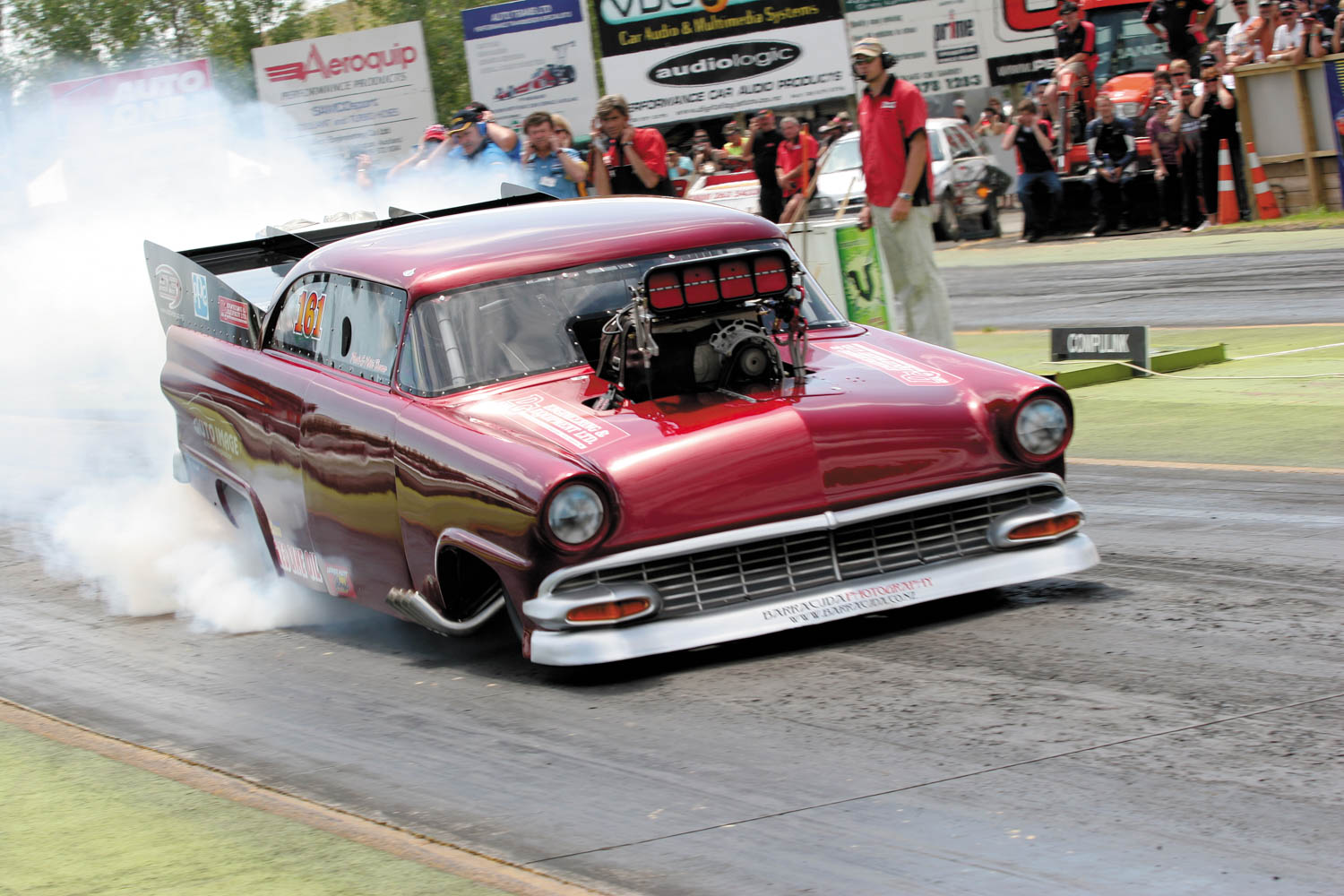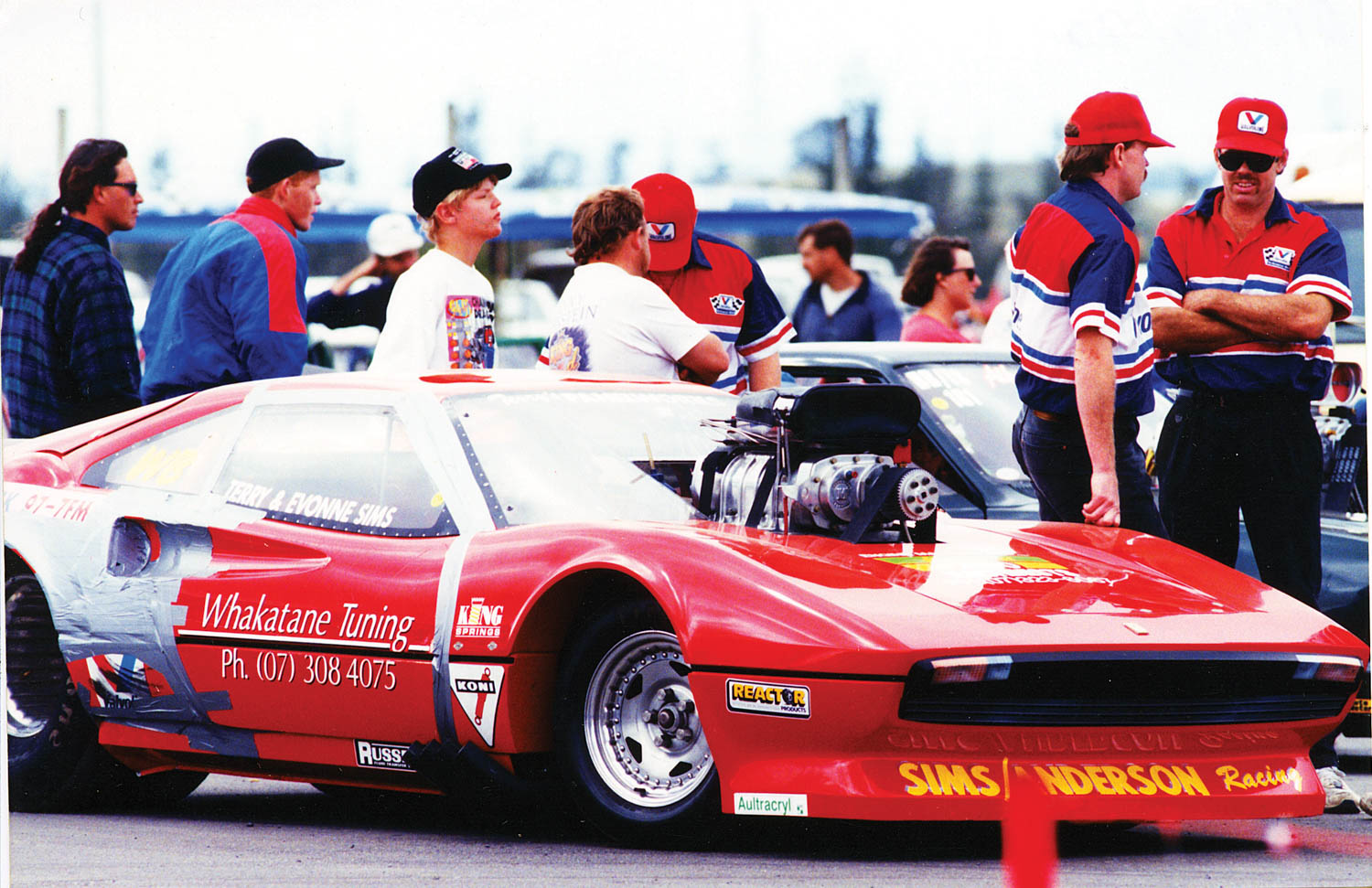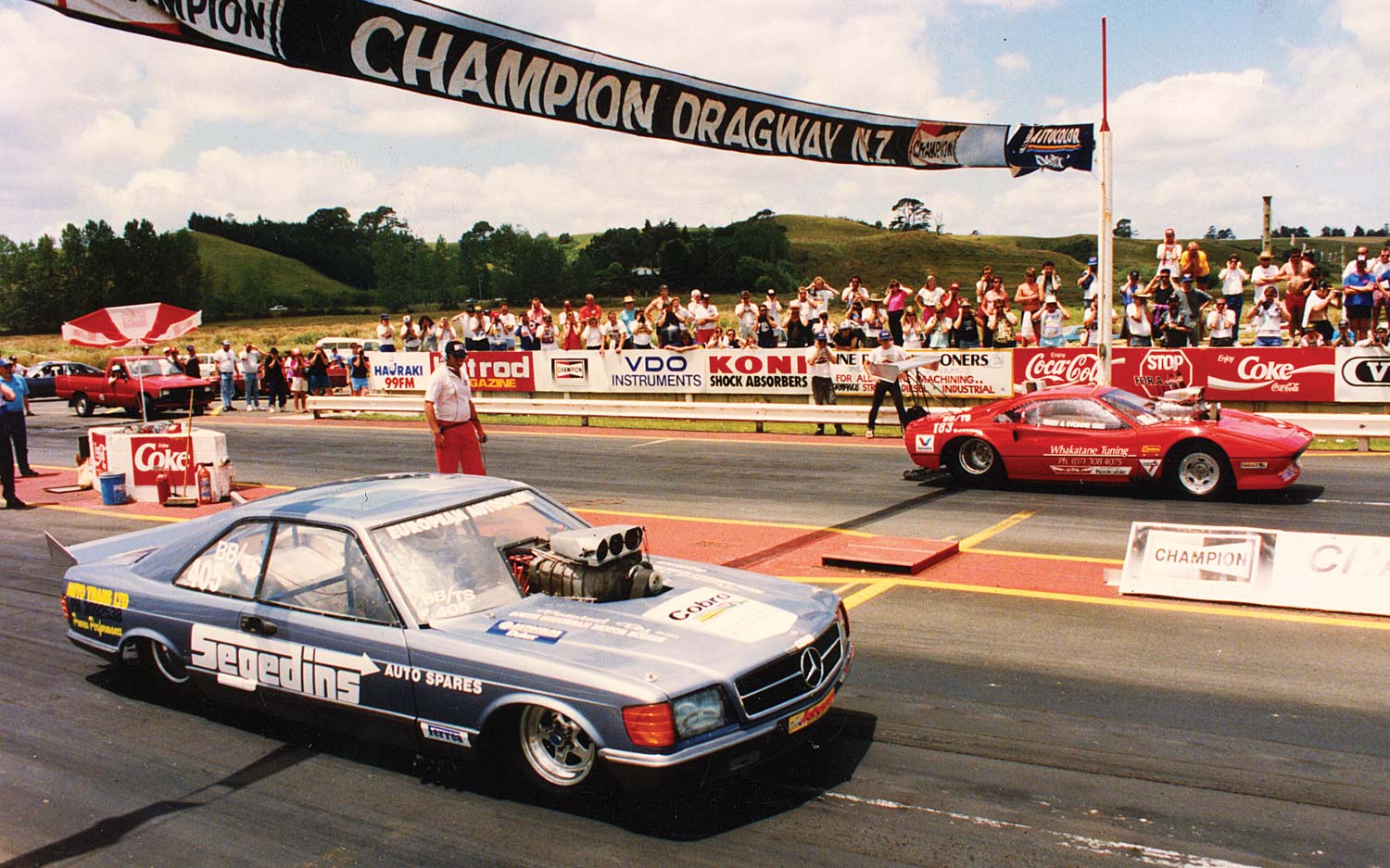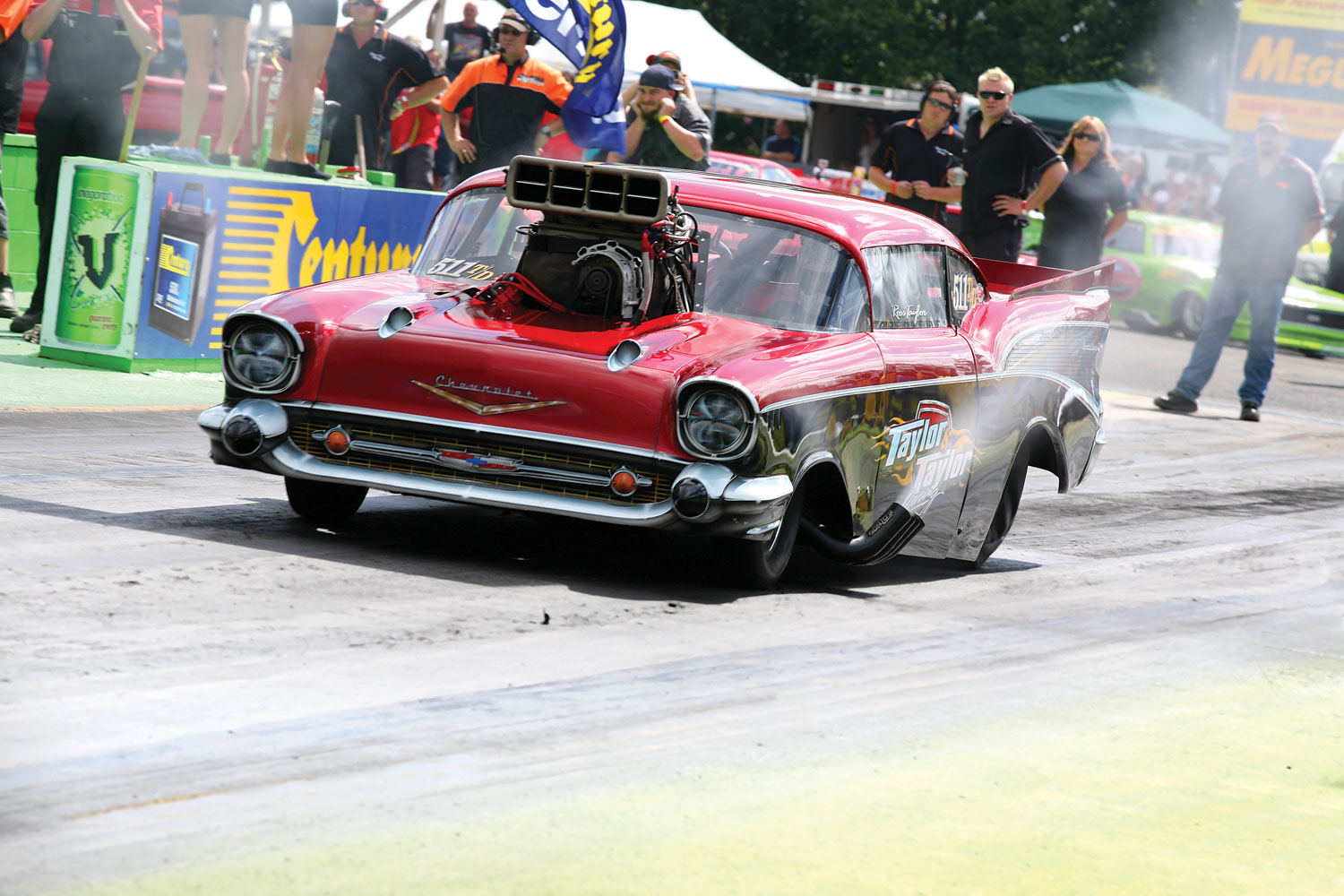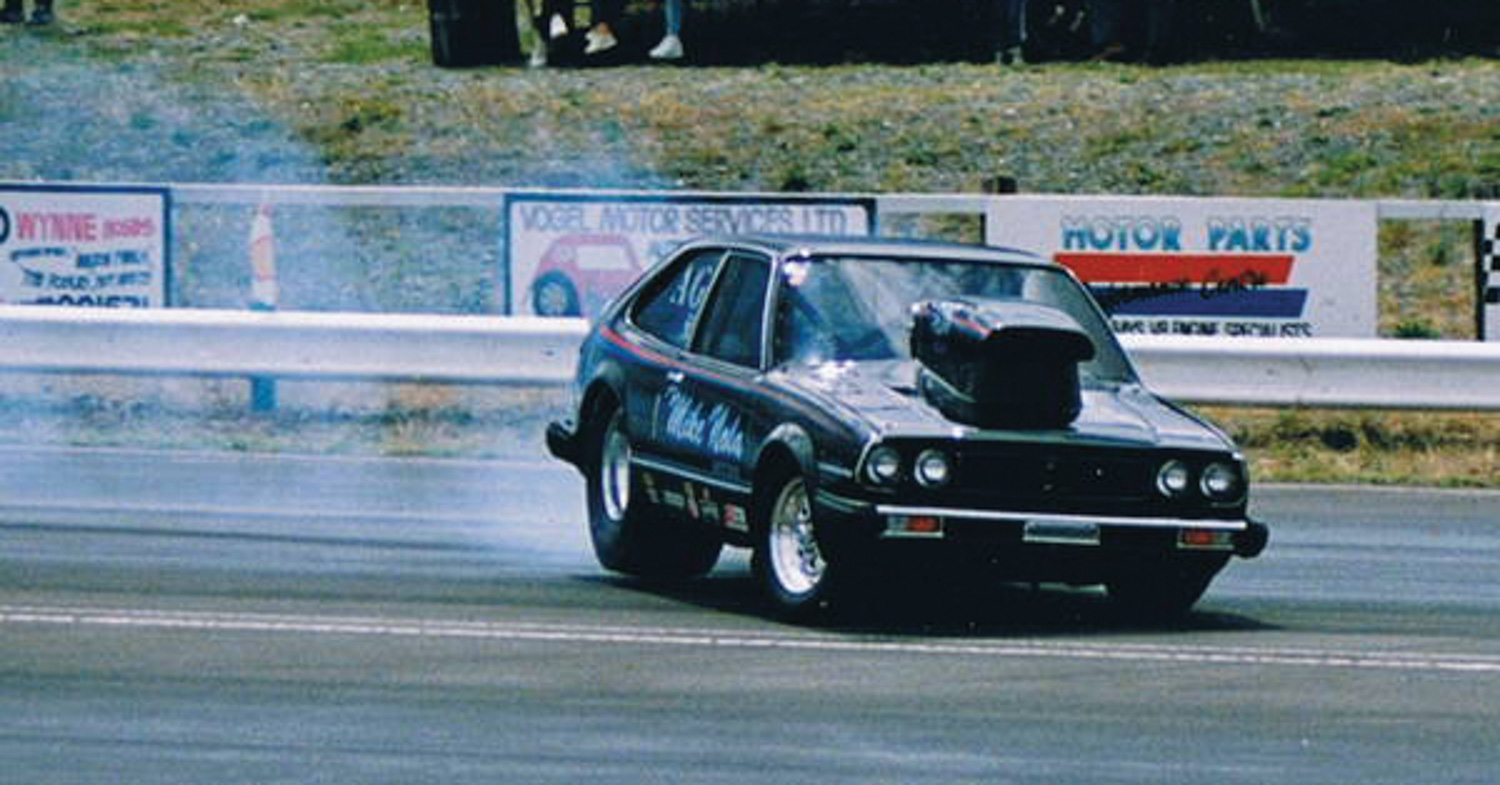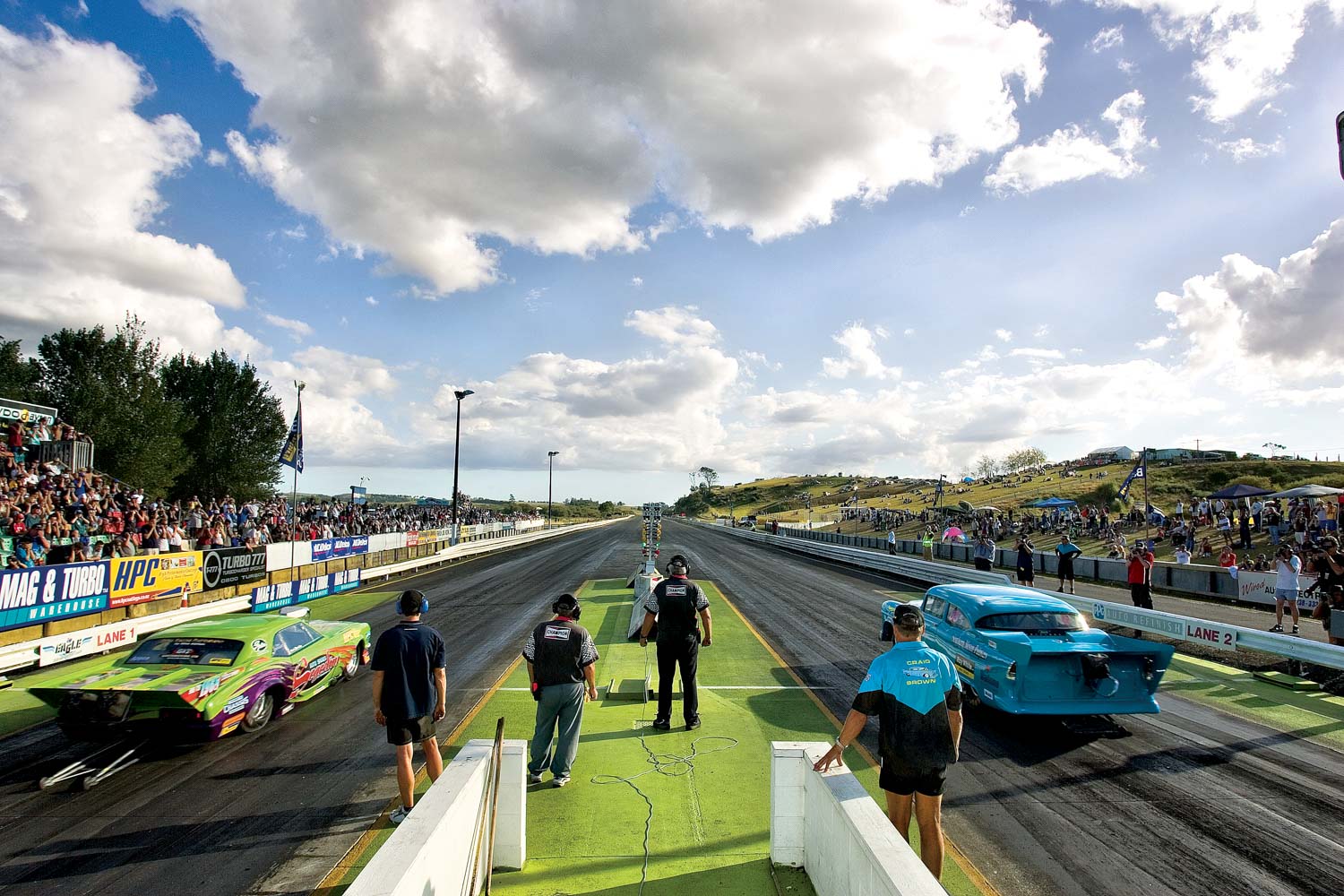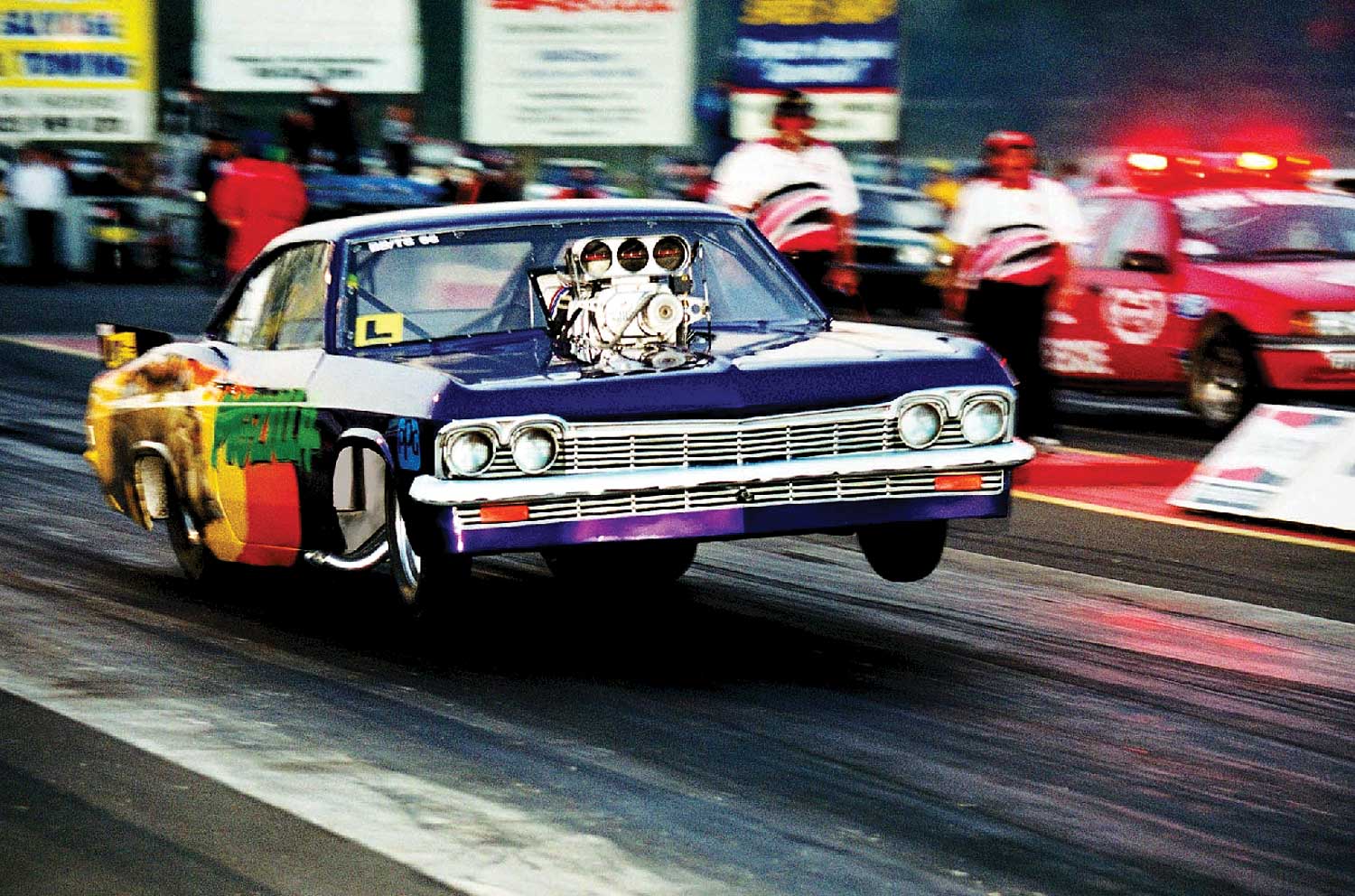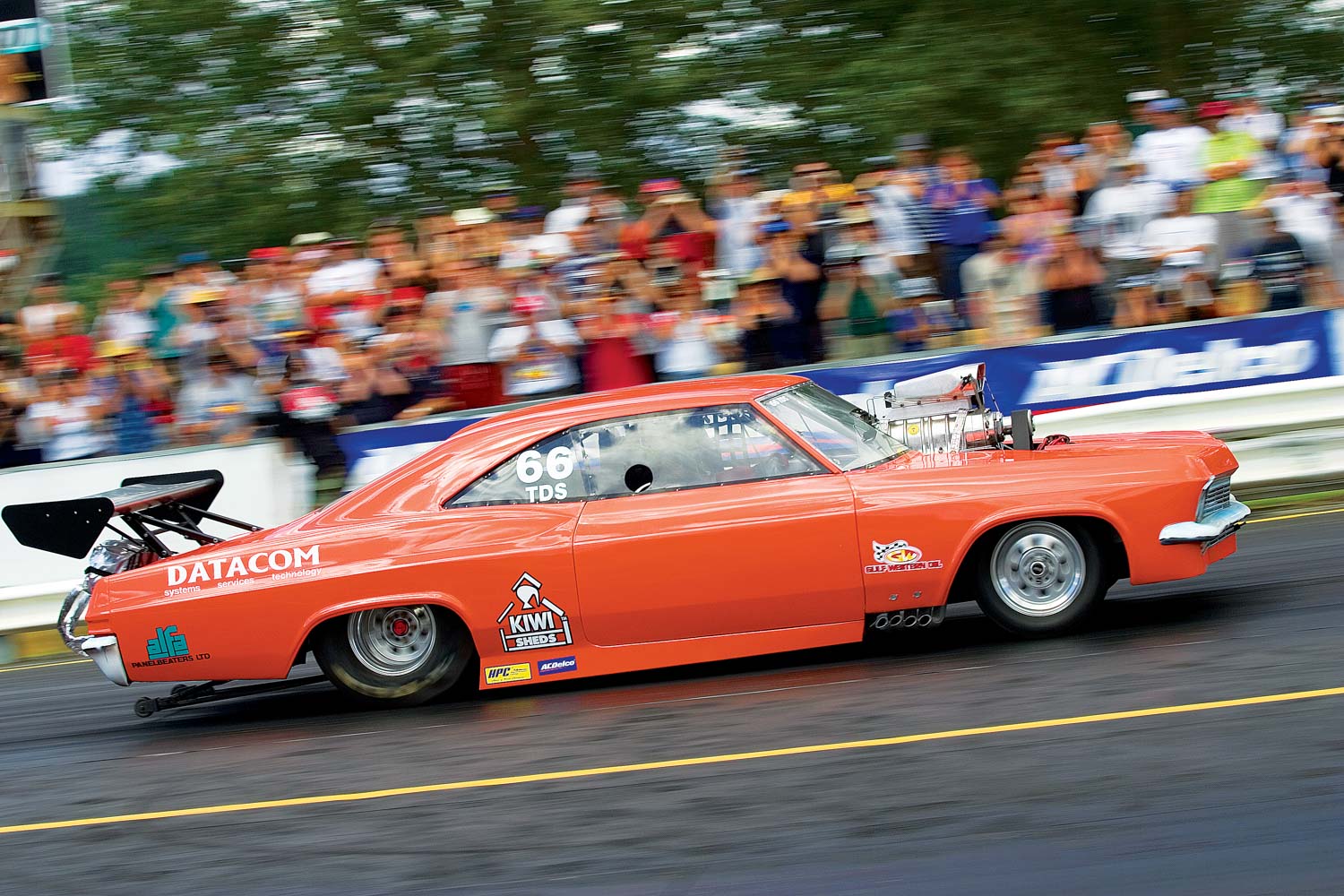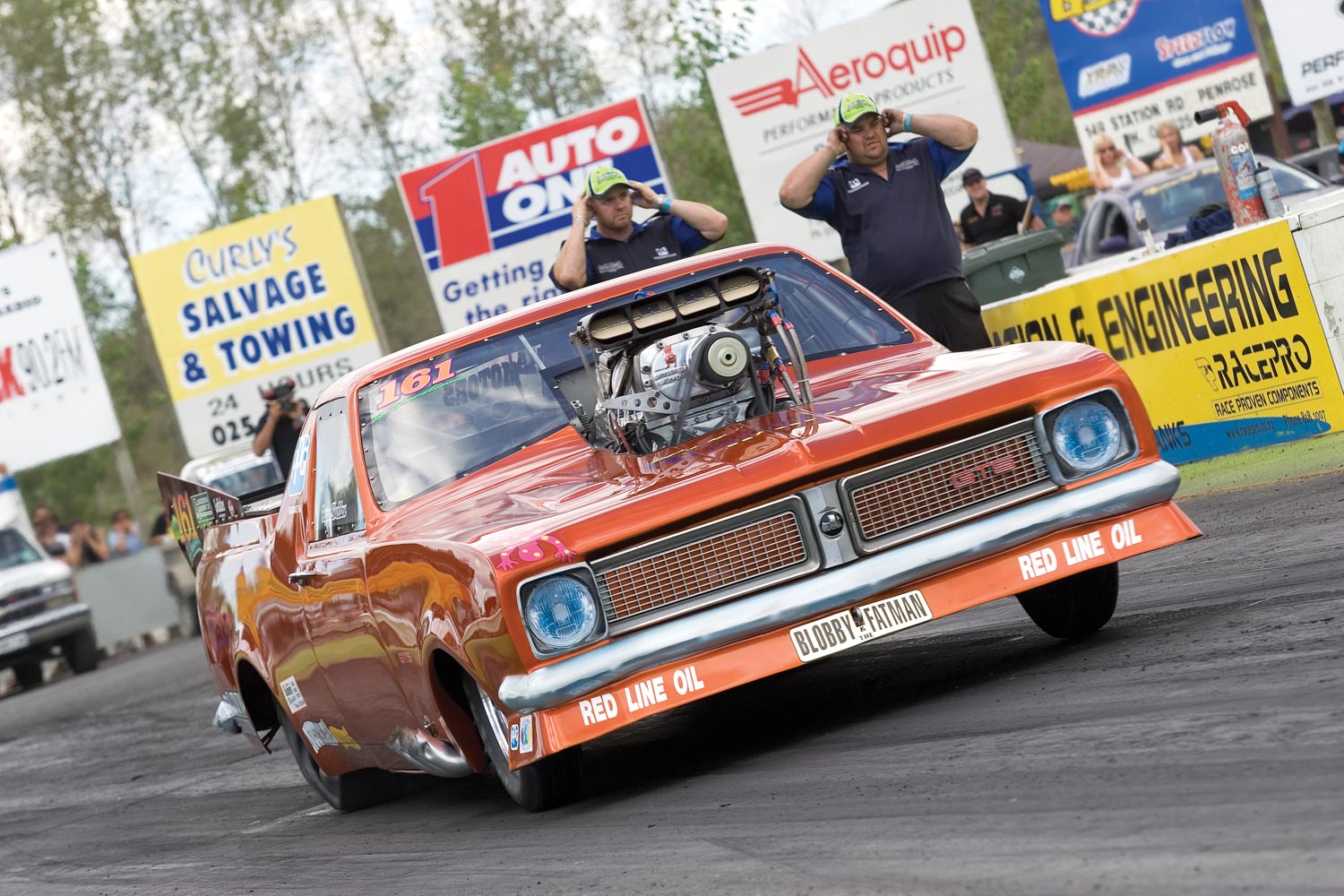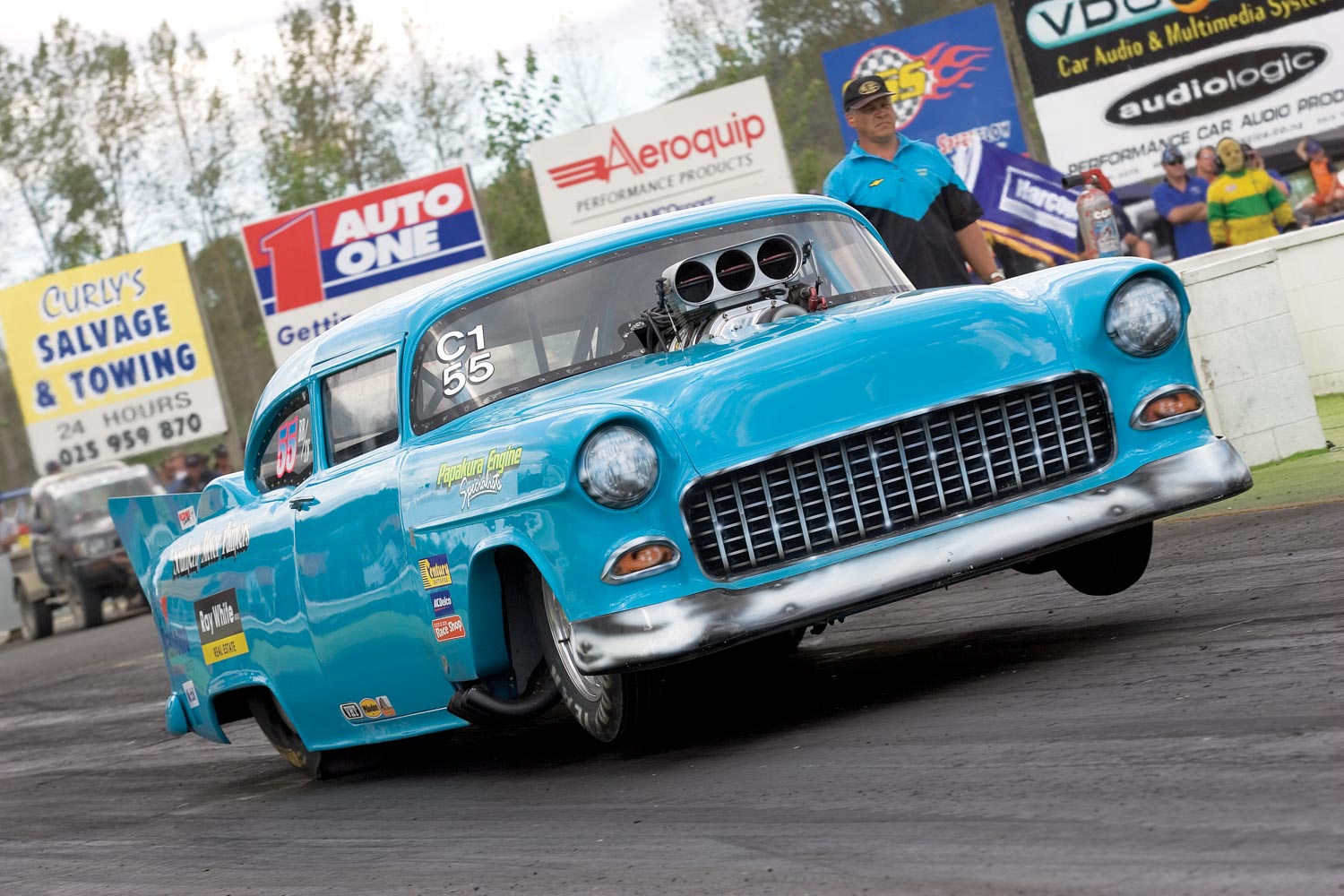data-animation-override>
“With New Zealand’s most prolific doorslammer recently celebrating 30 years of competition, we thought it was about time to look back and see how slammer racing evolved to the spectacle it is today. After we showcased part one last weekend, we’re now back with part two. Enjoy”
Mike Nola — Pontiac Trans Am, Pontiac Firebird, 1980s–1998 (New Zealand), 1999–current (Australia)

While many chose the supercharged route as the Wild Bunch era gained momentum, a few dipped their toes in the water with naturally aspirated / nitrous combinations, however few persisted to the level that Mike Nola did.
From the early days racing the big block Cortina, through the ex-‘Paton and Black’ Honda, culminating in the two pro stock–style Pontiacs that graced racetracks around the country, one thing remained constant besides the choice of power plant: the colour. Always black, and always with his business name emblazoned on the door: Mike Nola Motors.

While the Cortina started it all and the Honda (now in the hands of Terry Paterson) provided its share of wild rides, it was the ex-‘Scotty and the Chief’ Trans Am that kicked things up a notch or two. With the engine bay filled with over 500 cubes of GM’s finest, the car looked and sounded for the most part like the ‘factory hot rods’ of the day running Stateside. Repeatedly in the low eights in the early ’90s, Nola didn’t have anywhere near the same ponies as the supercharged entries but what he did have was consistency, and as they say, “to finish first, first you have to finish,” and he would finish first a bunch of times.
Early on in the ’92–’93 season Nola would grenade an engine while testing but when he returned a mere matter of months later it would be with a complete new short block from a company synonymous with Chevy power, Reher Morrison. The impact was immediate as Nola qualified the car second at its first meet and at the same time became the first man in NZ to record a seven-second naturally aspirated time slip, when he carded a 7.98 at Thunder Park.

Within a few seasons a new car was on the way, a Jerry Bickel–built 1996 Pontiac Firebird, which would be Nola’s last ride in New Zealand, because in late 1998 he, together with family and crew, packed everything up and moved across the Tasman. Before he left he dropped into the low seven-second range, a number which while he’s been in Australia has dropped to 6.75 with the now 632-cubic-inch nitrous-fed ’bird, a fixture at selected events running in the ultra-tough Competition bracket.
While the more popular ‘black belt’ cars in the bracket may have hogged a lot of the limelight, Mike Nola’s contribution cannot go unnoticed and more than deserves its place in Kiwi slammer history.
Trevor Tynan — 1965 Impala, 1990–present

Many race cars are bought or designed around a swoopy, low-slung profile. Some are built for the cool factor with copious amounts of horsepower on tap to compensate for the aerodynamics of a brick, but few evolve through the years without really changing the classic lines that they were born with.

The ’65 Impala of Trevor Tynan is one such car, instantly recognizable for the aircraft carrier–sized automobile it started life as, and instantly a crowd favourite as soon as she rolls through the burnout box and white plumes of smoke billow out from under the steel rear quarters.
As with any race car that’s been around this long, it has gone through many rebuilds, not just of its outward appearance but also to the many combos of engine gearbox and components replaced because of the big Impala’s healthy appetite for destroying anything remotely mechanical. Originally purchased from a wrecker in the late ’70s it would be the early ’90s before the car hit the track with serious intention. As the cubes rose so did the attrition on parts. With the odd decent timeslip thrown in along the way to renew hope of quarter-mile glory, the Impala would be thrown together with whatever could be bought, borrowed or stolen (not literally) to get it out there for the next race.

An early goal of running a seven-second pass with all-Chev running gear was achieved when the then-490ci big block, 12-bolt Chev diff and Turbo 400–powered ride dipped for the first time into the sevens in the mid ’90s. The big Impala had evolved and morphed from, in Trevor’s words, a “frightening, lurching, hunting, smoke-bellowing nightmare” to a more sedate nana’s car, and it was time to change things up a little.
A Lenco was added with a nine-inch rear end hung by a set of four-bars and the motor was increased in size to over 500ci with a decent set of Dart 360 heads. For a while the car ran with bracket-like consistency in the mid to high sevens. Long, powerful burnouts and skyward launches made the car a breeze to drive and the wild Steve Levine ‘Pigzilla’ paint scheme sure made it hard to miss.

More upgrades would lead to the form it is seen in these days — the Terry Bowden rear wing at the perfect height for storage of after-race beverages, and the monster 14/71 supercharger gracefully poking through the bonnet like it was always meant to be there. With its ‘Waikato orange’ hue doing nothing to disguise the size of the pig, it remains a crowd favourite to this day and the only car Trev has ever raced — and I suspect he would have it no other way. One can only hope that we all get to see it more regularly. Trev is not one to make too many plans in advance so I guess when and where we all see it next is anyone’s guess, but you can bet that when you do, you won’t be disappointed.
Vince Borowisc — Holden Camira, Holden Caprice, 1989–1996

A stalwart in the early days of Wild Bunch racing, Vince bought colour to the rapidly developing craze, not only by his antics on the track but also via the bright-yellow race cars that he piloted. Vince was probably one of the first to bring major branding to the side of the race vehicle and will forever be recognizable as the driver of the Agip Oils race cars of the day.
Firstly the Camira, then the Caprice, received the blown and injected big block–Chev treatment with various forms of success, running generally in the low eight- to high seven-second range. The Caprice passed through the hands of the Crook family from Wellington who ran it everywhere to a best of 7.9 seconds. It is once again set to rejoin the fray with twin-turbo small block power in the hands of Hamilton’s Shane Anderson.
Warren Brown — Plymouth Arrow, 1989–1991

Probably better known for a variety of blown altereds through the years and a horrific top-end crash at Meremere, Warren Brown did briefly step into the Wild Bunch ranks in the early ’90s, long enough to claim the first spot in the prestigious 160mph club of the time.
Call it a Plymouth Arrow, call it a Mitsubishi Celeste; it was a handful for those who owned it. With all the big block Chevs chasing the number, it was Warren with small block–Chev motivation who would get there first. Warren would move on to several different race cars, returning to ‘door car’ racing in a Dodge Daytona in Top Street. The Arrow, which will forever be remembered as New Zealand’s first 160mph slammer is now in the hands of Gavin Oram, and is set to be back on track soon, and faster than ever.
Craig Brown/Murray Smith — 1955 Chevy, 1992–present

To most drag racing fans the ’55 Chevy evokes memories of the ‘shoebox’ era of drag racing in the States, the early days of Pro Modified, and the basis of where ‘Wild Bunch’ racing in New Zealand originated. For Craig Brown his entry into Wild Bunch racing almost ended early on, barrel rolling his ’55 Chevy while testing on one of its first few passes.
With the passing of Steve Brown, an opportunity arose to purchase the fibreglass ’55 Chev body from Steve’s own tube-framed project that he would never get to finish. The shoebox has only ever been the one colour, and thus highly recognizable wherever it is raced. With its sky-blue hue and supercharged Chev, it has powered into the seven-second zone consistently over many years.
Over time the Chev has undergone the odd cosmetic change, along with engine and hardware upgrades, as many others have. When the NZDRA National Series was first introduced in 2004 it was Brown who claimed the overall national series title for Top Doorslammer. A handful of national titles and points series titles at his local track have followed, and many battles with Mark Bardsley in the early days when the Camaro was still small block–powered. Since 2008 the BB/TS record in the books has had the name Craig Brown alongside with a number of 7.355, many have come close or even beaten that mark but none have backed it up.
The last few years the driving duties have been shared between Craig and his engine-man Murray Smith. They’ve also shared the financial costs of running a Group One car and have had their fair allotment of issues as the push towards the six-second zone gained momentum. All the broken parts and issues with upgrading the 500-plus cube combo were soon forgotten at this year’s Nostalgia drags when, for the first time, the Brown and Smith ’55 ventured into the sixes with passes of 6.88 at 194mph and 6.90 at 197mph. With the 200mph barrier just around the corner you can bet it will be a long off-season as the team waits for that next opportunity to finally crack the double and join the elite names that have done so already.
Ross Taylor — 1957 Chevs, 2009–present

Ross has raced some form of ’57 Chev for most of his life. His super-stock version was fast and competitive and is still around — these days driven by his son, and crew chief, Jason. It was no surprise then that when the Taylor family decided to wade into Top Doorslammer their vehicle of choice would be something clothed in a 1957 Chevy skin.
Built way back in 1993 by Aussie chassis guru Murray Anderson, it was hugely successful in the hands of Peter Gratz before being re-skinned as a Dodge Daytona, then once again it was reverted to its ’57 Chevy guise by the Sarkis Bros team who purchased it from Gratz. Ross bought the car as a roller and with his dedicated family set about collecting and assembling it to be a competitive car. A 511ci TFX Hemi from Mark and Lucky Belleri was dropped in with all the fruit, and by the end of the team’s very first season they were the NZDRA national champions for Top Doorslammer.

With bests in the 6.40 range at well over 200mph, the car has plenty more left in it.
Mark Thomas — HT Holden Ute, Ford Customline, 1992–present

With the Wild Bunch craze gaining momentum in the early ’90s and a range of wild and exotic body styles emerging, it was the HT Holden ute of Mark ‘Blobby’ Thomas that would prove to be one of the more popular and most recognisable of the early blown slammers.
From a rusting shell in the Tynan back yard, the ute was chopped, sills removed, a tube frame added, and blown big block Chev dropped in, all in quick time, and New Zealand had another Wild Bunch car of note — a car that included a pretty cool piece of gear in between the massive rear slicks. The strange live axle rear end (in the car to this day) was actually a John Force piece, and top of the line when purchased. It wasn’t complete, so the necessary components were fabricated by Dave Green and the state of the art unit was installed.
Mark had been around the scene for a while as crewman for Dave’s ’Vette (which you’ll see next issue) and would prove himself more than capable in the rather confined cockpit of the ute. Despite a lack of tools, tow car or trailer in the early days, the ute was instantly competitive and running in the low eights by the end of the first season — a season in which Mark would proudly accept the rookie of the year award. Mark had no problem planting that right foot and keeping it there and the fans loved it, while the ute decided it loved transmissions, and the unit in use at the time, the good old Turbo 400, was devoured with monotonous regularity.

Phase two would see a change from ladder-bar to four-bar set-up, Lenco, titanium bellhousing and more power via a KB aluminium Chevy block. With a 10/71 supercharger the ute ran as quick as 7.1, but as with most of these stories the hunt was on for more. Sixes at 200 would have to be the ultimate goal for any ’slammer racer, and for Blobby that goal was no different — as well as keeping up with, and beating, a certain ’55 Chevy of the time, of course.
A 14/71 high helix would soon find its way onto the DG-constructed intake manifold, but it would be a long painful process until those barriers were finally broken. Although the ute dipped as low as 6.84 at 203, its happy place was in the 7.0 range and it would run there all day, every day, winning races and going rounds on any given race day. Like all forms of blown alcohol racing, there are always issues and you do whatever you can to get the car out there for the next round. There was the time after sideswiping Tom Richardson on a wild ride, that squashed headers were re-opened with a jack handle and it was duct-taped back together with busted fibreglass, all within the time constraints of the hour-or-so turnaround. At Ruapuna with the front cover cracked and leaking oil, an ice cream container was strapped under the pulley with a ‘containment rag’ taped inside so as to not drop any oil on the track; surprisingly it actually worked and the ute completed the day, just another example of doing whatever is needed to put on a show.
With performance levels rising in the Top Doorslammer era, a BAE Hemi was purchased — but installing the physically larger engine in the ute and getting the weight balance correct was never going to work. A chance conversation with Victor Bray while in Australia crewing for Tim Watkins, alerted Mark to Andrew Searle’s Top Doorslammer ’56 Customline that was up for sale. A deal was struck, the Cusso was put in a box and sent back to Godzone. The ute has since been on-sold to a new owner in Wellington and the Cusso, with the Hemi installed, has been as quick as 6.6 with limited track time. With a striking Dean Riche paint job and monster PSI supercharger poking through the carbon fibre front, the Cusso looks stunning and has the potential to be one of the quickest of all time in this country.
Terry Sims, Tim Watkins, Mike Witteveen — 1972 Ferrari 308, 1993–present

When Ferrari’s chief designer, Leonardo Fioravanti, designed the 308 series in the early ’70s I bet he never thought one would become a supercharged, methanol-burning monster of the quarter-mile in little-old-New Zealand. At just over 105 inches it’s not exactly the ideal base for a 2000hp door car, but for Terry Sims it was the perfect place to start.
As a 17-year-old apprentice in Whakatane, Terry Sims met a fellow apprentice by the name of Mike ‘Bic’ Anderson. The two would go on to racing an altered; Terry as the driver, Bic as crew chief. After mixed success the pair met Les Herst who started helping with Powerglide transmissions. Soon after, the altered became too slow for the pair, and the hunt began for something else. Terry had just restored a 308 Ferrari for a customer, and asked the owner if he could take a mould of the car, to which the customer agreed.

Terry did the mould himself and built the chassis, while Bic looked after the engine and running gear. It was a long time coming, but when it debuted in the summer of ’93 all were impressed with its craftsmanship and the fact that someone had thought out of the box and come up with a Ferrari, of all things.
The combination included the first pair of symmetrical-port pro-stock heads in the southern hemisphere. With a 6/71 and a variety of Powerglides, the car ran mid eights. The hunt for even more power led the pair to Jim Oddy’s workshop in New York, with one of the heads in tow. Bic recalls, “He checked my head, flowed the hat, advised of some changes required and off we went. Jim is a great guy, he didn’t hand me the set-up on a plate, but [he] made me aware of what really goes on through a run.” The Powerglides made way for a three-speed Lenco, and the blower for an 8/71. After a season of learning how to run the new combination, the times started to tumble, running as quick as 7.55 at 188mph at Thunder Park. That mph record for a BB/TS car still stands to this day.

The short wheelbase proved challenging at best, down right scary at worst, and guardrails and photographers were targets in the early outings. The Ferrari would consume Terry, ultimately costing him more than he was willing to give, and when an offer was made by a guy named Tim Watkins, who had previously never driven anything more than a street car, a deal was done and the bright red Ferrari had a new owner.
Now anyone who knows Tim knows he has a heavy right foot and a no-fear-never-lift attitude when it comes to racing, and in his early days it was no different, start as you mean to go on they say. With the addition of bead-lock wheels to the familiar helicopter landing pad disguised as a rear wing and an Oddy power plant, the now-flamed Ferrari took on a whole new persona. Tim would take the long road to six-second glory, destroying his fair share of parts and pieces along the way and by the time that milestone was achieved Tim’s racing career had become a two-car operation with his focus shifting to the Top Alcohol Funny Car ranks, where he continued very successfully in the following years.

It was 2005 when Mike Witteveen took ownership and set about rebuilding certain aspects of the car and generally tidying up all the little things that usually get ignored and put off until ‘next season’. With a new coat of Ferrari Red, a monster 14/71 supercharger and nearly 500 cubes of Chevy’s best, Mike, also a novice before strapping himself into the Ferrari, has stopped the clocks as quick as the 7.4s. He also became only the second BB/TS-classified car to win the Top Doorslammer National Championship when he claimed the title in 2010, proving you don’t necessarily have to have the fastest car in the land to claim all the marbles. Always upgrading and looking for that leap in performance, the Ferrari in Mike’s hands is impeccably presented and pushing hard for a return to the six-second range.
While Enzo himself may not have approved of the course that one of his flagship cars has taken, I think we can all agree it’s made for one of the most recognizable and most crowd-pleasing slammers the country has ever seen.
This article was originally featured in a previous issue of NZV8. Pick up a copy of the edition here:










